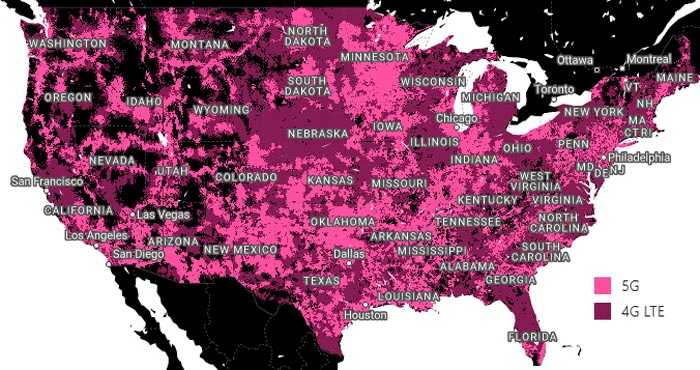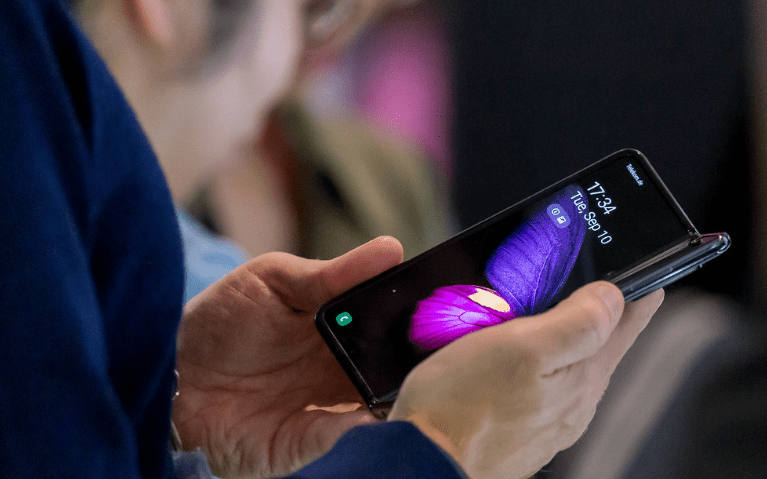The revolutionary 5G cellular network service we’ve been hearing about for years isn’t quite there yet. But each month, 5G networks grow bigger around the country. Currently, all four nationwide U.S. carriers offer some version of consumer 5G service. Along with this, new devices are soon to hit shelves that will break the 2019 price barrier.
The result is that, within the year, most people should have some form of 5G available to them on a more affordable device. Within the next two years, however, we’ll see true market penetration.
Read on to learn more about the current state of 5G networks in the U.S. Be sure to check back often as these numbers will change quickly throughout the year.

What Do 5G Networks Mean for Me?

For your smartphone, 5G is all about speed. What you’ve probably seen in the news is that with 5G, you’ll be able to download a movie in less than 5 seconds. This is true. Eventually, it may even be quicker than. Along with this, 5G also means:
- Faster download and upload speeds
- More reliable mobile connection
- Stream online content more smoothly
- Improved voice and video call quality
- Greater number of Internet-of-Things devices
- Expansion of advanced technology like robotic surgeries, self-driving cars, and smart cities
5G is more than speed, however. It also means reduced latency. Latency is the delay in time before a transfer of data begins following an instruction for its transmission. In general, the lower the latency, the better the user experience.
Reduced latency is the key to the last two features of 5G networks. That is why tech experts are predicting 5G will unlock capabilities from augmented reality (A.R.) and virtual reality (V.R.) technologies and other innovations.
The Different Types of 5G

To know if there is 5G near you, you need to know that not all 5G is created equally. There are three types of 5G: low, middle, and high-band. For the time being, however, most 5G in the U.S. is focused on either low or high-band deployment. This is contrary to other countries that use mid-band networks.
- High-band: AT&T, Verizon, T-Mobile (a little). 10x faster than LTE and very low latency.
- Mid-band: Sprint. 6x faster than LTE, smaller footprint than low band.
- Low-band: T-Mobile, AT&T. 20% faster than LTE, large coverage area
Low-band 5G uses sub 2.5 GHz signals to operate. It’s capable of covering vast distances, about 1000 square miles from cell towers. However, speeds aren’t as high. Low-band speeds average around 150Mpbs (megabits per second). This is about 3-4 times faster than average 4G LTE speeds. The advantage, however, is you’ll be able to get signal in more places.
On the other hand, high-band 5g (also known as MM Band) uses 24 GHz and above signals. These waves travel much faster, but over short distances. In effect, you need to be relatively near to a 5G cell tower to receive reception. In testing, these speeds average between 1-2 Gbps (Gigabits per second) or 30-40 times faster than average 4G LTE speeds.
Over the next few years, cellular providers will weave together low, high, and eventually middle-band signals to create true 5G networks. For the time being, however, things are a bit patchy. All networks rely on 4G LTE as a backup for when no 5G signal is available (much like how 4G relied on 3G in the past).
We’ll now review the current state of 5G networks in the U.S.
1) T-Mobile 5G Network

T-Mobile has had the most success so far with its 5G network. It decided to focus on low-band 5G and, in December 2019, launched a 5G service that covers 200 million Americans across 500 towns and cities, including suburban and rural communities.
At the same time, they’ve also launched a high-band network in six cities and growing. T-Mobile’s merger with Sprint is expected to give the company access to mid-band signals, which will further expand its 5G network capabilities.
To access T-Mobile’s 5G network, you need a 5G-compatible device and Magenta plan or higher starting at $70 per month. There’s no additional cost for 5G.
2) Sprint 5G Network

Sprint has 5G running in nine cities: Atlanta, Chicago, Dallas, Houston. Kansas City, Los Angeles, New York City, Phoenix, and Washington, D.C. Unlike the other carriers, it’s focusing on mid-band 5G as it has spectrum available in these frequencies.
The advantage of mid-band is that it had the right combination of higher speeds with a more massive range. This is a significant reason for the T-Mobile and Sprint merger and will help T-Mobile weave together a comprehensive 5G network.
To access Sprint 5G, you don’t have to pay extra but must sign up for the Unlimited Premium plan, which starts at $85 per month.
3) AT&T 5G Network

AT&T is working on both a low-band and high-band 5G network, which is now available in 35 major cities around the country. Their goal is to have a low-band nationwide network by mid-2020 as well.
You don’t have to pay extra to access AT&T’s 5G network, but you will have to sign up for the United Extra, or Unlimited Elite plans starting at $75 per month.
4) Verizon 5G Network

Verizon is taking a different approach and is focused mainly on high-band 5G. Now available in 28 cities around the country. As far as speed ratings go, Verizon (like its 4G LTE network) is the fastest.
Currently, you have to be on a Verizon $80 a month to access 5G, although it’s planning to charge $10 per device on top of fees.
Who Has the Best 5G Network?

It depends on what you’re looking for. The problem Verizon’s high-band network is that it drops very quickly if you’re out of range from a cell tower. On the other hand, T-Mobile may not offer the fastest speeds, but it has a broad coverage map.
If you want to get a taste of 5G right now, your best option is T-Mobile. You see the fastest speeds, but you’ll get the most use of your 5G device. Keep an eye on things to see when 5G is coming to you.
The last question to answer is whether now is the right time to upgrade to a 5G device. 2020 is the year of the 5G scale. It’s right on the edge of a large number of affordable devices and larger amounts of network availability.
By upgrading now, you may pay a little more, but you can take advantage of free access to 5G that all the carriers are offering. You’ll also have a device that’s ready to grow with the 5G network. But if you do decide to upgrade, make sure it supports low, middle, and high-band signals. That will be the best way for you to use 5G both in the U.S. and abroad.
Visit the Buyback Boss Blog to learn more about 5G, cellular networks, and smartphones. Do you still have questions about mobile service? Learn about the differences in GSM and CDMA networks in this guide. To help you choose the right network, we’ve also broken down the differences between the top nationwide and budget carriers. Get started with this comparison of Cricket vs. T-Mobile. For all things technology, head on over to our blog now!






